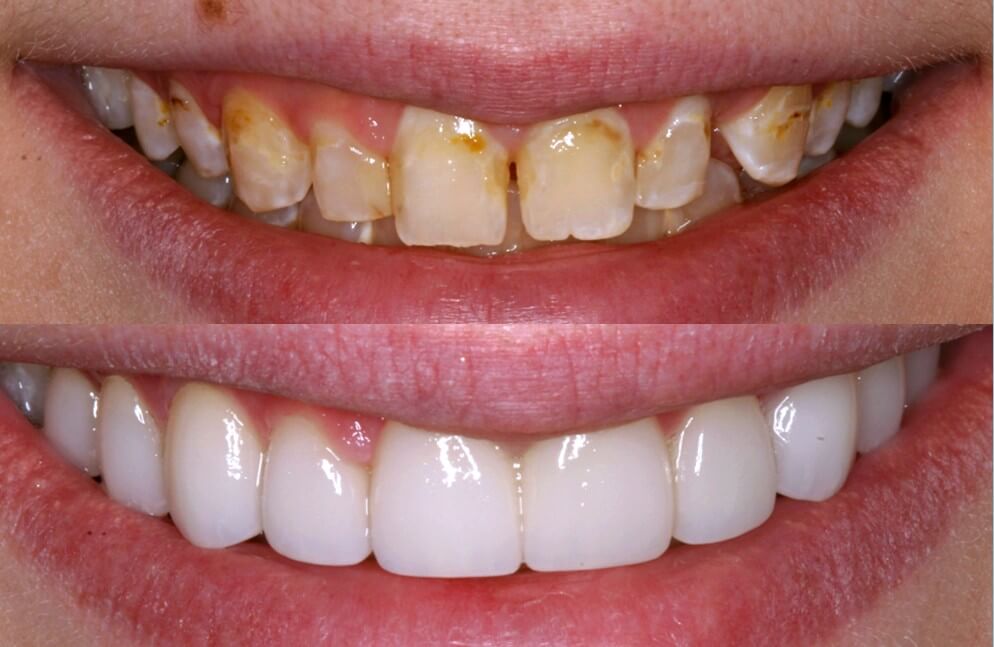What is a veneer?
A veneer is a thin layer of porcelain made to fit over the front surface of a tooth, like a false fingernail fits over a nail. Sometimes a natural-colour ‘composite’ material is used instead of porcelain.
When would I need a veneer?
Veneers can improve the colour, shape and position of your teeth. A precise shade of porcelain can be chosen to give the right colour to improve a single discoloured tooth or to lighten your front teeth. A veneer can make a chipped tooth look whole again.

The porcelain covers the whole of the front of the tooth, with a thicker section replacing the broken part. Veneers can also be used to close small gaps, when orthodontics (braces) are not suitable. If one tooth is slightly out of position, a veneer can sometimes be fitted to bring it into line with the others.
Advantages of veneers?
Veneers make teeth look natural and healthy. Because they are very thin and are held in place by a special, strong adhesive, very little preparation of the tooth is needed. Some types of veneers don’t need any preparation at all.
How are teeth prepared for a veneer?
Some of the shiny, outer enamel surface of the tooth may be removed, to make sure that the veneer can be bonded permanently in place later. The amount of enamel removed is tiny and will be the same as the thickness of the veneer to be fitted, so that the tooth stays the same size.
A local anaesthetic (injection) may be used to make sure that there is no discomfort, but often this is not needed. Once the tooth has been prepared, the dental team will take an ‘impression’ (mould). This will be given to the dental technician, along with any other information needed to make the veneer.
The colour of the surrounding teeth is matched on a shade guide to make sure that the veneer will look entirely natural.
How long will it take?
A veneer takes at least two visits. The first is to prepare the tooth and match the shade, and the second is to fit it. Before bonding it in place, your dentist will show you the veneer on your tooth to make sure you are happy with it. Bonding a veneer in place is done with a special adhesive, which holds it firmly on the tooth.
Will I need a temporary veneer between visits?
Because the preparation of the tooth is so slight you will probably not need a temporary veneer. The tooth will look very much the same after preparation, but will feel slightly less smooth.
What happens after the veneer is fitted?
Only minor adjustments can be made to the veneer after it is fitted. It is usually best to wait a little while to get used to it before any changes are made. Your dental team will probably want to check and polish it a week or so after it is fitted, and make sure that you are happy with it.
How much will it cost?
The costs for this treatment can vary from person to person and quality of the material used for making a veneer.
How long will a veneer last?
Veneers should last for many years; but they can chip or break, just like your own teeth can. Our dental team will tell you how long each veneer should last. Small chips can be repaired, or a new veneer fitted if necessary.
What about alternatives?
A natural-coloured filling material can be used for minor repairs to front teeth. This is excellent when the tooth can support a filling, but may not work so well for broken tooth corners. There will always be a join between the tooth and the filling material.
Crowns are used for teeth which need to be strengthened – either because they have broken, have been weakened by a very large filling, or have had root canal treatment.
Crowns
A dental crown is a “cap” placed over a tooth. When cemented into place, crowns fully encase the entire visible portion of a tooth that lies at and above the gum line. The document lists situations in which crowns may be needed.

What is a dental crown?
A dental crown is a tooth-shaped “cap” that is placed over a tooth. The cap restores the tooth’s shape and size, strength, and appearance.
The crowns, when cemented into place, cover the visible portion of a tooth.
When would a dental crown be needed?
A dental crown may be needed to:
- Protect a weak tooth (for example, from decay) from breaking or to hold together parts of a cracked tooth
- Restore a broken tooth or a severely worn down tooth
- Cover and support a tooth with a large filling and not much tooth remaining
- Hold a dental bridge in place
- Cover misshaped or severely discolored teeth
- Cover a dental implant
- Cover a tooth treated with a root canal
What types of crown materials are available?
Permanent crowns can be made from all metal, porcelain-fused-to-metal, all resin, or all ceramic.
- Metals used in crowns include gold, palladium, nickel, or chromium. Metal crowns rarely chip or break, last the longest in terms of wear down, and only require a small amount of tooth to be removed. They can also withstand biting and chewing forces. The metallic color is the main drawback. Metal crowns are a good choice for out-of-sight molars.
- Porcelain-fused-to-metal dental crowns can be matched to the color of the teeth beside them. They have a more natural tooth color. However, sometimes the metal under the crown’s porcelain cap shows through as a dark line. Other drawbacks are that the crown’s porcelain portion can chip or break off and there is more wearing down of the teeth opposite them in the mouth. (The top and bottom tooth that come into contact when the mouth is closed.) These crowns can be a good choice for front or back teeth.
- All-resin dental crowns are less expensive than other crown types. However, they wear down over time and are more likely to break than porcelain-fused-to-metal crowns.
- All-ceramic or all-porcelain dental crowns provide the best natural color match than any other crown type. They are also a good choice for people with metal allergies. However, they are not as strong as porcelain-fused-to-metal crowns. They also may wear down the teeth opposite them in the mouth a little more than metal or resin crowns. All-ceramic crowns are a good choice for front teeth.
- Pressed ceramic crowns have a hard inner core. They replace the metal liner that is used in the all-ceramic crown-making process. Pressed ceramic crowns are capped with porcelain, which provides the best natural color match. They are also more long-lasting than an all-porcelain crown.
What are “onlays” and “3/4 crowns?”
Onlays and 3/4 crowns are crowns that don’t cover as much of the underlying tooth as traditional crowns. Traditional crowns cover the entire tooth.

